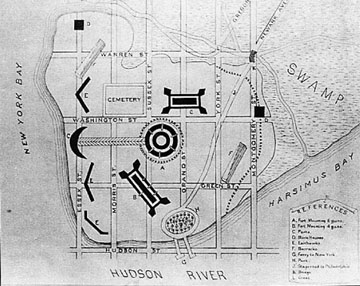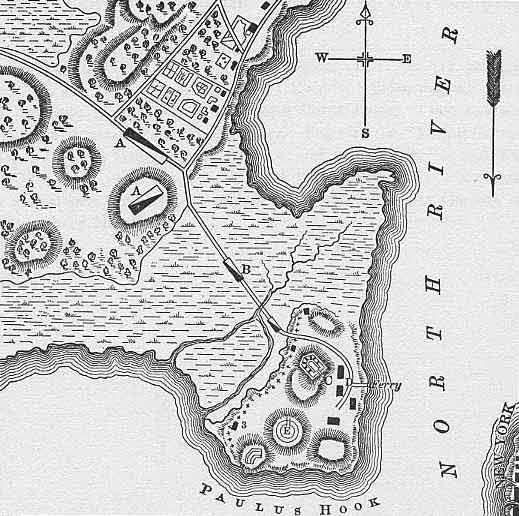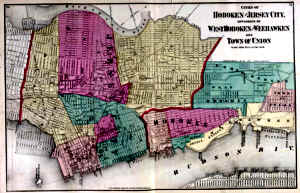History, Pictures and Information of Jersey City,
Morris Canal, Paulus Hook.
Jersey City’s Hook
By Richard B. Marrin
The cries of “Colgate”, “Liberty Harbor” and
“Exchange Place” are familiar ones now to ferry travelers between Manhattan
and Jersey City. But before 9/11 and the destruction of the PATH connection, few
ever visited this pleasant community of giant office towers and well kept, 19th
century brownstones. Known to the purist as Paulus Hook, this part of Jersey
City has, like much of the New York harbor waterfront, layers upon layers of
history upon which we commuters can reflect.
Dutch days
Michael Paulsen of the Dutch West Indies Company began it all
when, in 1633, he erected a fur trading hut on a spit of high sand dunes that
jutted into the Hudson. The spot became Powles’ Hook, the philological
ancestor of today’s Paulus Hook. Westward were wetlands, a swampy marsh,
dotted with small islands. Beyond that, laid the wilds of North America!
In 1638, Abraham Planck bought the property for 450 guilders.
He was going to put it to agricultural use, but never got much of a chance.
Indian uprisings, brought about in part by unscrupulous trade practices of the
Dutch, led to the burning of the first settlements. Planck and the Dutch
colonists were forced back across the Hudson to New Amsterdam.
A Busy Place in the 1700’s
In 1699, Cornelius Van Vorst paid 300 pounds “current money
of New York” for the property. The site had already earned a spot in history.
Two thirds of a century before, William Jansen had established the first ferry
service across the Hudson there. But, it was the Van Vorst family that would
convert Paulus Hook into a transportation hub, linking New York with points to
the west and south. It is a role it still plays today.
An item from the New York Gazette and Weekly Mercury, of April
11, 1768, under the headline “Good News for the Public” announced the
arrival of “The long wished for Ferry from the place called Powles’s Hook to
the City of New York”. The boats were wide, flat bottomed periaugers, which
made the trips across the river “as the wind served”. They were “properly
constructed for the convenience of passengers, horses and carriages alike” and
Paulus Hook was “thought by far the most convenient place for a ferry of any
yet established, or that can be established, from the Province of New-Jersey to
the City of New-York. The distance between to the two points was only 3/4 of a
mile and low tide did not hinder landing at either location”. Another
advantage was that “in the Winter season, [there] is rarely a day but that the
boats may pass at this ferry without being obstructed or endangered by ice”.
Once across the Hudson, the traveler from New York could catch
a stage to Newark every Wednesday and Thursday between 2 and 3 pm. Fare was a
shilling. The owners, “endeavored to oblige the Public by keeping the best of
Wagons and sober Drivers”. Even then, they sought the business traveler:
“Persons may now go from New York to Philadelphia and back again in five days,
and remain in Philadelphia two nights and one day to do their business”.
A Colonial Meadowlands!
Believe it or not, back then Paulus Hook had a race track. In
1769, Van Vorst laid out a mile long race course on the roughly circular Hook,
that ran around the sand hills and up along the edge of the upland. The New York
Journal of October 12, 1769 covered a four horse, best two out of three heat,
competition with a 50 pound purse. The three mile race was decided only in the
final heat when Anthony Rutger’s horse Luggs “had the misfortune in the last
heat to run over a dog, which occasioned him to fall and throw over his Rider
(who was much hurt)”.
|
Fort Paulus Hook during the Revolution
Everyday pursuits are put aside in times of
crisis. That was true of Paulus Hook during the Revolution. Strategically
located, it became one of a string of forts guarding the Hudson River and
the rebel-held New York City. The fort sat at the crossroads of Grand and
Washington streets. The site is remembered today as a park.
In the summer of 1776, only months after the defiant Declaration of
Independence had been read, a huge British fleet arrived in New York
harbor to subdue the rebel movement. The Paulus Hook fort came under
attack. The journal of the Rev. Benjamin Boardman, chaplain to the
Continental troops stationed there, reported how three large ships sailed
up the Hudson and “kept up an incessant fire upon us. Their shot, a
large part of which was grape, raked the whole Hook, but providentially
one horse was all we lost by it.” The Chaplain had mixed emotions. He
obtained “a livelier idea of the horror of war” than he had ever
known, but it also gave him “great pleasure to see the spirit of the
troops, who were evidently animated by the whistling of the enemy’s
shot, which often struck so near as to cover them with dust.” |

If you stepped off a ferry from New York to Paulus Hook
in 1779, this is what you would find. A far cry from today.
|
|
The position had to be abandoned. The
British captured New York City and, for the first time, occupied a piece
of New Jersey. Three years later, however, it had all come full circle. By
then, Britain had concentrated its forces in New York and Paulus Hook had
become Britain’s last toehold in New Jersey. Several hundred patriot
troops, under the command of Henry Lee, made a surprise raid on the fort
there. The British had more than 50 killed and wounded and 158 captured.
American losses were but two killed, three wounded.
Post War Boom/Bust/Boom
In 1804, the Van Vorst family sold the 117
acres of Paulus Hook to a group of leading citizens from New York and
Newark. They had great plans for the spot — a city on the other side of
the Hudson to rival New York. The rent was high and “perpetual” —
6,000 Spanish milled dollars a year, secured by an unredeemable mortgage.
The Associates of the Jersey Company, as they came to be called, were
represented by an eminent Wall Street attorney, Alexander Hamilton (his
face is on the $10 bill in your pocket). Hamilton’s expertise and
influence were needed. He drafted the legislation, for the Jersey
Legislature to pass, that would give the Associates what amounted to
municipal authority to lay out roads, build piers and enforce regulations
by fines. He also had to secure a waiver from New York of its claim that
it owned both shores of the river. New York obliged, selfishly mindful
that ferry service out of the colony “would greatly tend to the
convenience of the inhabitants of this city in case of the return of the
[smallpox] epidemic.”
About 15 people lived on Paulus Hook before
May 14, 1804, when 1344 lots in this new community were put up for sale.
Van Vorst had put in a small, semi-circular park at the foot of today’s
Grand and Hudson Streets, where the ferries came in. Next to it were a
tavern, a ferry house, an oyster house, stables, and some storehouses. The
Associates urged Robert Fulton to take a block of waterfront, roughly
where Hudson street is now, for his steam vessels that were to
revolutionize shipping. A hotel was planned (Hudson House), shade trees
planted and space reserved for a school, churches, and a public market. A
distillery was erected near the corner of Hudson and Essex, as were a
steam saw and grist mill, a pottery works and a glass factory.
But the town did not develop as hoped.
Three things discouraged investment there: the fear that New York would
claim jurisdiction of the shore and wharves, the irredeemable mortgage
given to the Van Vorsts which prevented full ownership of the property and
the fact that the town was governed by the Associates, not its citizens.
By 1834, there were only 1500 people and 170 houses on Paulus Hook. A 19th
century historian noted: “Lawlessness reigned. Prize fighting, bull
baiting and dog fighting were common amusements, with drunkenness and
gambling”.
Things got better. New York dropped its
claims; the Van Vorst mortgage was bought back and Paulus Hook became part
of what would become Jersey City. By 1850, the population of Paulus Hook
had grown to 7,000. The boom was due to another innovation in
transportation, the train. In 1837, the New Jersey Railroad built its
terminal on the Paulus Hook waterfront, later enlarged by the Pennsylvania
Railroad. There, at Exchange Place, the disembarking train traveler could
board a ferry to New York or find transportation to Newark and other
points in New Jersey.
Isn’t “exchanging” what we still do
here? Is it any different at Paulus Hook today despite, all the new
construction going on? Once more, history suggests that the more things
change, the more they stay the same.
|
History Events of Jersey City
1609 Henry Hudson anchored "the Half Moon" in New York Harbor.
1630 Michael Pauw bought land for trading purposes on the west bank of
the Hudson and called the area Pavonia.
1633 Michael Paulusen, a Dutch trader, erected a dwelling at Paulus Hook.
1636 Cornelius Van Vorst built a home near the present 4th and Henderson
Streets.
1643 Pavonia settlement destroyed by Indians.
1646 Peter Stuyvesant became Director General of New Netherlands.
1655 Pavonia settlement again destroyed by Indians.
1660 Bergen Township established on site of the present-day Bergen
Square.
1779 Major "Light Horse" Harry Lee captured Paulus Hook fort
from the British on August 19.
1804 Associates of the Jersey Company bought Van Vorst family land and
then sold lots in Paulus Hook on May 15.
1804 Robert Fulton established his shipyard at Green and Morgan Streets;
8 years later sailed steamboat "The Jersey" to New York in 14
minutes.
1820 The Paulus Hook area was incorporated as the City of Jersey City,
but remained part of Bergen Township.
1827 Joseph Dixon Crucible Company established.
1829 The first police force, the Watch, was formed.
1836 Morris Canal extension to Jersey City completed; railroad service
begins.
1838 Jersey City became independent of Bergen Township with Dudley
Gregory as first mayor.
1840 Hudson County was formed.
1841 Van Vorst Township (Harsimus) separated from Bergen Township.
1843 Bergen Township was divided into Bergen and North Bergen.
1847 First Cunard liner docked at Jersey City, "The Hibernia."
1851 Township of Van Vorst added to Jersey City on March 18.
1852 Town of Hudson separated from North Bergen.
1862 Bayonne separated from Bergen.
1863 Greenville separated from Bergen.
1870 Hudson City, Bergen, and Jersey City consolidated.
1871 New City Charter;first paid Fire Department.
1872 First public high school. William L. Dickinson named Superintendent
of Schools.
1873 Greenville joined Jersey City on August 11, thereby giving Jersey
City its present land boundaries.
1894 Hudson (now Kennedy) Boulevard opened. (Runs down the center of
Hudson County)
1896 City Hall completed.
1901 Main Library building opened.
1904 Boonton reservoir opened.
1908 First route of Hudson and Manhattan tubes (now PATH) opened.
1916 "Black Tom" (now part of Liberty State Park) Explosion,
July 30.
1917 Frank Hague became mayor.
1921 Dempsey-Carpentier fight at Boyle's 30 Acres, July 2.
1924 Colgate erects new clock: largest outdoor timepiece in the world.
1927 Holland Tunnel opened ten years before Lincoln Tunnel was dedicated.
1931 Margaret Hague Maternity Hospital opened.
1937 Roosevelt Stadium opened. (Now the site of Society Hill Townhouses
of Rt 440)
1946 Jackie Robinson broke organized baseball's "color line" at
Roosevelt Stadium
1947 Hague retired as mayor.
1949 Hague political organization defeated by John V. Kenny.
1960 Jersey City Municipal government's Charter revised.
1967 End of railroad ferry service to New York City.
1976 Liberty State Park opened.
1993 Liberty Science Center and Hall of Technology opened.
1994 Ferry service to NY City resumes.
1996 WALDO district created for artists.
1997 Light rail construction begins.
|
|
|
Battle Plan of Paulus Hook
The British kept permanent possession of two or three places on the western side of the Hudson. One of these places was Paulus Hook, now Jersey City. The Hook was a peninsula made up of steep, rocky hills, and surrounded in part by the Hudson and in part by a marsh intersected by creeks and ditches.
The position, strong in itself, was fortified with palisades, block-houses, and redoubts. It was occupied by a battalion of New Jersey Tories, under Lieutenant-colonel
Bushkirk.
PAULUS HOOK
(FROM THE LIBRARY AT CASSEL) |
|
Plan of the surprise of an English post at Paulus Hook, in the Province of Jersey, at half-past two in the night of the 18th-19th of October, 1779.
A. Approach and position of the rebels on the heights of Bergen, to cover the retreat.
B. Attack on the bridge and the blockhouses 1, 2, and 3, and on the fort C, which mounted seven 6-pounders. These did not succeed in firing.
D. Barracks in which the English garrison, one hundred and ten strong, were taken prisoners.
E. Work which a Hessian captain and one officer with twenty-five men occupied ; whereupon the rebels retired at daybreak, with their prisoners. |
 |
On the 18th of August, 1779, a party of forty Hessians, with two officers, were brought over to reinforce the garrison of Paulus Hook, and at nine in the evening of that day Bushkirk started on an expedition towards the new bridge over the Hackensack, some fourteen miles distant. Meanwhile, Major Henry Lee, of Virginia, with about three hundred men, supported by Lord Stirling with about five hundred more, approached the new bridge in the opposite direction, under pretence of foraging. Here Stirling halted, but Lee during the night came near Paulus Hook, having passed Bushkirk unperceived. On approaching the fort, Lee sent an officer, with a small party, forward to
reconnoitre. The officer reported that the garrison were not on the alert. Lee then advanced with his command. They forded the ditches, entered the fort, and surprised a number of Provincials, sleeping in a block-house. They then approached a second blockhouse, occupied by a small party of Hessians.
"Wer da?" cried the sentry. "Stony Point!" answered the Americans. The sentry fired, and thus gave the alarm, but the under-officer in command of the block-house surrendered with ten or fifteen men. Lee next surprised and took possession of the principal redoubt, and the whole of Paulus Hook seemed his. Fortunately for themselves, however, some twenty-five Hessians had their wits about them. They threw themselves into a small redoubt, where they were joined by their captain and by Major Sutherland, commanding the post, and refused to yield. Lee, who had not known that any Hessians were in the fort, and who probably overrated their numbers, made off before morning without even spiking the cannon or destroying the war material. He took with him about one hundred and fifty prisoners. Lee had received orders not to attempt to hold the place, and a rapid retreat was necessary to prevent his being cut off; but the twenty-five Hessians, by their gallant conduct, had probably prevented the capture or destruction of the stores and buildings in the fort, and had certainly saved their side from the appearance of a complete and shameful disaster (Marshall, vol. iv. pp. 87-92 ; Washington, vol. vi. pp. 317, 326, 332, 333, 336, 376; Bancroft, vol. x. p. 229 ; Ewald's
"Belehrungen," vol. ii. pp. 295-299; MSS journals of Chasseur Corps, Regiment von Lossberg
(Piel and Heuser), Wiederhold's Diary. See also the "Life of General Henry Lee," by General Robert E. Lee, prefixed to Lee's "Memoirs of the War," etc. General R. E. Lee says that Paulus Hook was entered by a stratagem, but this statement is not confirmed by any German account, nor by Marshall.)

|
|
